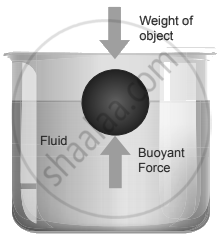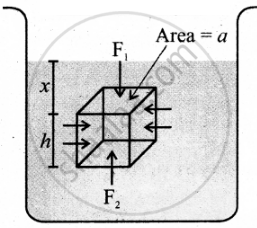Advertisements
Advertisements
Question
State and prove Archimedes principle.
Solution

Archimedes principle
Archimedes principle states that when a body is partially or wholly immersed in a fluid, it experiences an upward thrust equal to the weight of the fluid displaced by it, and its upthrust acts through the center of gravity of the liquid displaced.
Proof: Consider a body of height h lying inside a liquid of density p, at a depth x below the free surface of the liquid. The area of a cross-section of the body is a. The forces on the sides of the body cancel out.

Buoyant force on a body
Pressure at the upper face of the body,
P1 = xρg
Pressure at the lower face of the body,
P2 = (x + h)pρg
Thrust acting on the upper face of the body is F1 = P1a = xρga acting vertically downwards.
Thrust acting on the lower face of the body is F2 = P2a = (x+h)ρga acting vertically upwards.
The resultant force (F2 – F1) is acting on the body in the upward direction and is called Upthrust (U).
∴ U = F2 – F1 = (x + h)ρg – xρga = ahρg
But, ah = V, the volume of the body = volume of liquid displaced.
U = Vρg = Mg
[∴ M = Vρ = mass of liquid displaced]
i.e., upthrust or buoyant force = Weight of liquid displaced.
This proves the Archimedes principle.
APPEARS IN
RELATED QUESTIONS
State Pascal’s law in fluids.
State Archimedes principle.
What do you mean by upthrust or buoyancy?
State the law of floatation.
Derive an equation for the total pressure at a depth ‘h’ below the liquid surface.
State and prove Pascal’s law in fluids.
We can cut vegetables easily with a sharp knife as compared to a blunt knife. Why?
